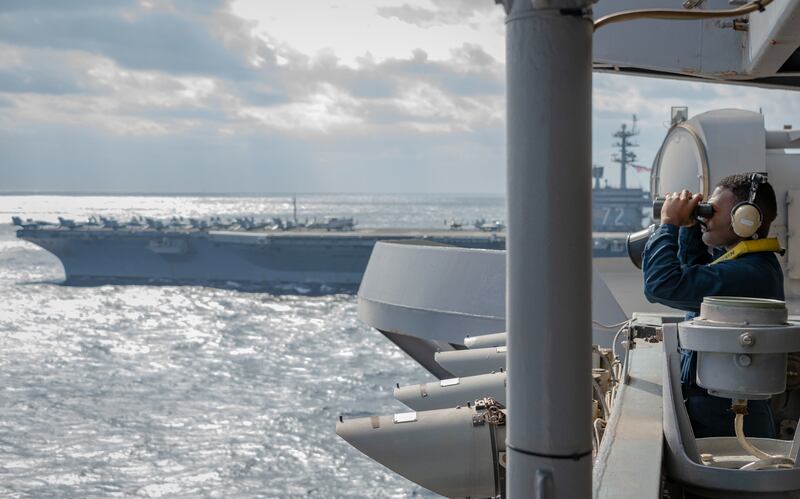China sent 39 military aircraft into Taiwan’s Air Defense Identification Zone (ADIZ) on Sunday, the same day two U.S. Navy Carrier Strike Groups began a joint operation in the South China Sea.
The Chinese sorties included 34 J-16 and J-10 fighter jets, four Y-8 and Y-9 electronic warfare aircraft and an H-6 bomber, according to Taiwan’s defense ministry.
Taiwan scrambled fighters and issued radio warnings while air defense missile systems were deployed to track the Chinese aircraft activities, the ministry said.
The incursion, the largest since October, highlighted the cross-strait tension and also served as a warning message to Taiwan and the United States, said a prominent Taiwanese analyst.
By this, China wanted to say to the U.S. that it should think twice about the freedom of navigation operations (FONOPs) “rather than taking them as a matter of course,” said Ming-Shih Shen, acting deputy chief executive officer at Taiwan’s Institute for National Defense and Security Research (INDSR), a government think-tank.
On the same day, the USS Carl Vinson and USS Abraham Lincoln Carrier Strike Groups with more than 14,000 sailors and marines began dual carrier operations in the South China Sea, the U.S. Navy said. They had earlier joined a military drill in the Philippine Sea.
The Navy said the carrier strike groups “will engage in joint operations to include enhanced maritime communication operations, anti-submarine warfare operations, air warfare operations, replenishments-at-sea, cross-deck flight operations and maritime interdiction operations to strengthen maritime integrated-at-sea operations and combat readiness.”
“The training will be conducted in accordance with international law in international waters,” it said.
Just one day before that, the two carrier strike groups took part in a joint exercise with the USS Essex Amphibious Ready Group, the USS America Expeditionary Strike Group and Japanese Navy helicopter destroyer JS Hyuga in the Philippine Sea.
The strike groups’ precise location on Monday was not immediately clear.
Observers said China would not turn a blind eye to such a show of force. Last October when the U.S. Navy was conducting joint drills with British and Japanese ships near Okinawa, the Chinese military sent a record 145 fighter planes to Taiwan’s ADIZ prompting the Taiwanese minister of defense to say that cross-strait tensions were “at their worst in 40 years.”

Strategic waterway
Beijing has yet to comment on the latest event. In the past, it had said that such flights were to protect its sovereignty and target “collusion” between Taiwan and the U.S.
China considers Taiwan a breakaway province that should be “reunified” with the mainland while most Taiwanese people see their homeland, which is democratic and self-governing, as a sovereign, independent state.
An ADIZ is an area where civilian aircraft are tracked and identified before further entering into a country’s airspace. It does not restrict travel in and out of its limits, nor does it usually apply to military aircraft, although there is no international rule or law saying it cannot.
Taiwan’s ADIZ roughly corresponds to its exclusive economic zone, a 200 nautical mile boundary off its coasts. However, usually only those PLA flights that cross the median line between Taiwan and mainland China are reported as incursions.
A map provided by Taiwan’s Defense Ministry showed the Chinese aircraft flew in an area to the northeast of the Taiwan-controlled Pratas (Dongsha Islands) in the South China Sea.
“This area is at the crossroad between strategic waterways from the Taiwan Strait and the Bashi Strait to the South China Sea,” explained Ming-Shih Shen from the INDSR think tank.
“China’s intensified flights here can, on the one hand, block military assistance from Taiwan to Dongsha Islands, and on the other hand monitor the entry of U.S. naval and air forces into the South China Sea.”
“Intrusions of Chinese military aircrafts in Taiwan’s ADIZ at a large scale are designed to eventually turn the Taiwan Strait into the inner sea of China. China would then have actual control of the Taiwan Strait and even the Bashi Strait,” Shen said.
“Countries [in the region] must pay attention to China’s naval and air force deterrence in the Taiwan Strait, and the South China Sea,” he said.
The U.S. Navy, meanwhile, insisted that U.S. ships’ presence and activities in the region are to “support a free and open Indo-Pacific.”
Rear Adm. Dan Martin, commander of the Carl Vinson Carrier Strike Group, was quoted in the Navy web portal as saying on Monday: “We are committed to ensuring the lawful use of the sea and free flow of commerce while deterring those who challenge the shared vision of a free and open Indo-Pacific now and into the long-term future.”
